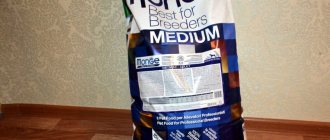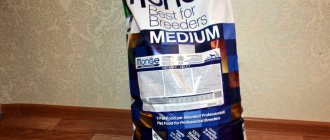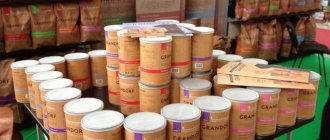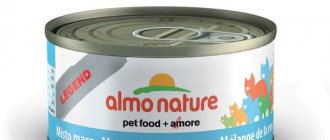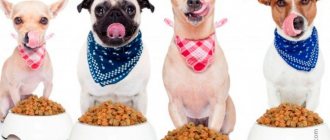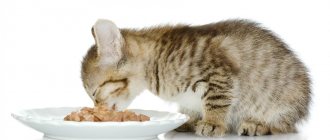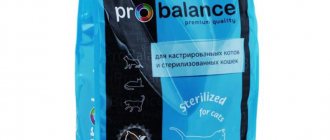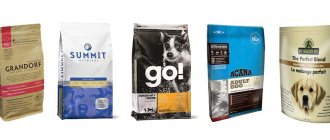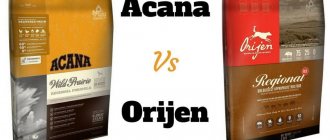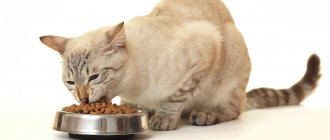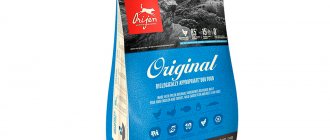Cat food is the key to good health, activity and happiness of your pet. Attentive owners notice that often the cat’s behavior depends not only on external factors, but also on the food consumed. Most owners select food based on personal preferences, advice from friends or via the Internet. To ensure adequate nutrition, you should pay attention to products with the most natural composition. Analysis of product quality, as well as studying the food line will help you find a suitable composition for your cat.
general information
Orijen dry food belongs to the holistic category. This is a sign of the highest quality: such products contain only safe ingredients, the share of meat in some cases reaches 80–90%. The list of ingredients is close to natural nutrition, in which animal proteins should make up the same amount of the total food.
The logo is present on all food packaging, but depending on the specialization of the formula, only one icon is left: cat or dog
Champion PetFoods produces Orijen food. It also produces Acana dry food, which also belongs to the holistic class. The factory is located in Canada, which increases confidence in the manufacturer. This guarantees that the products undergo thorough testing to ensure compliance with quality criteria. In addition, Canada is one of the most environmentally friendly countries. Processing of raw materials is carried out in the same place where they are mined, so the possibility of spoiled ingredients getting into the feed is excluded.
Champion PetFoods was founded in 1975. The factory is located in the small town of Morinville: in 2016, less than 10 thousand people were registered there.
The corporation adheres to the principle of biological matching. The company tries to include ingredients that a cat would eat in the wild. Champion PetFoods does not just purchase raw materials or raise poultry and fish. The corporation either purchases meat from environmentally friendly farms or catches fish in natural reservoirs. When raising poultry and farm animals, growth stimulants, antibiotics and hormonal drugs are not used. They try to provide the animals with the opportunity to roam freely: this way, meat products will be closest to their natural counterparts.
Freeze-dried meat is the safest treat for cats
Additionally, the company produces a line of dog food. There are also Orijen treats. They cannot be used as a complete diet because they do not contain all the necessary vitamins and minerals, but they can be offered to pets as a reward or for variety. The line of delicacies includes not only standard treats with fish and chicken, but also products with lamb, wild boar or deer meat. There are no unnecessary components or fillers in the composition: only 100% meat.
Reviews
Reviews often found on ORIJEN cat food are, of course, positive. They don't need advertising. They gained their popularity thanks to positive reviews from veterinarians and experienced breeders.
ORIGEN belongs to the category of universal feeds. However, when choosing food for your cat, carefully monitor its reaction. Even food of this level is not always suitable for demanding pets.
Sources:
https://zverki.click/koshki/pitanie-koshki/obzor-kormov-dlya-koshek-oridzhen-orijen.html https://dalmspb.com/pitanie/obzor-korma-dlya-koshek-oridzhen-i-otzyvy -veterinarov-117547/ https://mirkotyat.ru/pitanie/otzyvy-o-kormah/korm-dlya-koshek-orijen.html
Types of Orijen food
There are only 4 positions in the food line. There are no specialized therapeutic and preventive diets, since the products already contain a set of therapeutic additives. The company does not produce wet food.
Cat food Orijen Cat & Kitten
Orijen Cat & Kitten dry food is suitable for cats and kittens of all breeds. The product is complete, i.e. it does not require additional additives (vitamins, minerals, dietary supplements, etc.) provided that the animal is absolutely healthy. Dry food can be given to pregnant, lactating and elderly cats, i.e. there are no age restrictions.
Good nutrition from childhood is a guarantee of good health in the future, because it is at a young age that the final formation of all systems and internal organs occurs
The dry food contains the following ingredients:
- fresh chicken (18%);
- fresh turkey meat (7%);
- fresh whole eggs (5%);
- fresh chicken liver (5%);
- fresh whole flounder (4%);
- fresh whole herring (4%);
- fresh turkey liver (4%);
- fresh chicken heart (4%);
- fresh turkey heart (4%);
- fresh chicken necks (4%);
- dehydrated chicken (4%);
- dehydrated turkey (4%);
- whole mackerel, dehydrated (4%);
- whole sardine, dehydrated (4%);
- whole dehydrated herring (4%);
- chicken fat (3%);
- red lentils;
- green pea;
- green lentils;
- chickpeas;
- yellow peas;
- lentil fiber;
- beans;
- whole navy beans;
- dehydrated chicken cartilage (1%);
- herring fat (1%);
- freeze-dried chicken liver;
- freeze-dried turkey liver;
- fresh table pumpkin;
- fresh butternut squash;
- fresh zucchini;
- fresh parsnips;
- fresh carrots;
- fresh apples;
- fresh pears;
- fresh kale;
- fresh spinach;
- fresh beet leaves;
- fresh turnip greens;
- kelp;
- whole cranberries;
- whole blueberries;
- whole berries of serviceberry;
- chicory root;
- turmeric;
- milk thistle;
- burdock root;
- lavender flowers;
- marshmallow root;
- dog-rose fruit.
The first 16 positions are occupied by products of animal origin. Their total amount with other meat components is 85%. 15% is allocated to plant components. In Orijen feeds they are not used as a cheap filler, but to provide animals with the necessary vitamins and minerals, as well as to prevent various diseases. For example, cranberries and blueberries help increase urine acidity and prevent stone formation. Berries reduce the risk of developing cystitis, pyelonephritis and other infectious diseases of the genitourinary system due to the atypically high pH for many bacteria.
The flat shape of the granules is a good solution: it does not allow animals to swallow the pieces whole
The calorie content of dry food is 416 kcal per 100 g. It is not advisable to use it if you are overweight. Despite the high calorie content, in most cases, with a normal appetite, the product does not provoke obesity: the cat receives more essential nutrients from a smaller amount of food and gradually limits portions on its own. The share of proteins is 44%. The amount of carbohydrates is not specified. They are represented by low-glycemic compounds that provide the animal’s body with energy gradually. The share of fats is 15%.
Orijen Cat & Kitten food is good for kittens, but be careful with older animals. Once, due to lack of experience, I advised my friend to switch her cat, who was prone to allergies, to Orijen products, since she herself gave it to her animals. As a result, six months later the cat developed liver problems and urolithiasis. I would not blame the food for this, but I would still advise you to refrain from a sudden transition from economy and premium class to Orijen holistic products. This is not an isolated case of deterioration in health despite a seemingly balanced diet. Cats are conservative; their internal organs have time to get used to low-quality food, so a sudden transition is dangerous for adult animals. Sometimes it’s even smarter to go super-premium.
Orijen Fit & Trim cat food
The manufacturer recommends using Orijen Fit & Trim dry food if your cat has problems with excess weight. In fact, a ready-made diet can be offered to animals without a tendency to overeat and gain weight, but the consumption of the product will increase. This is due to its low calorie content. It is not recommended to give this food to pregnant and lactating animals unless absolutely necessary. In such cases, it is better to prefer a ready-made diet for kittens.
The impact of food on the body can be compared to a proper diet: the manufacturer replaces high-calorie meats and fish with chicken and turkey
The dry food contains the following ingredients:
- fresh chicken (14%);
- fresh whole eggs (6%);
- fresh whole herring (6%);
- fresh turkey meat (6%);
- fresh chicken liver (6%);
- fresh whole flounder (4%);
- fresh whole mackerel (4%);
- fresh whole Pacific hake (4%);
- fresh turkey liver (4%);
- fresh chicken heart (4%);
- dehydrated chicken (4%);
- dehydrated turkey (4%);
- whole mackerel, dehydrated (4%);
- whole sardine, dehydrated (4%);
- whole dehydrated herring (4%);
- dehydrated pollack (4%);
- lentil fiber;
- red lentils;
- green lentils;
- green pea;
- chickpeas;
- yellow peas;
- beans;
- navy beans;
- dehydrated chicken cartilage (1%);
- fresh turkey heart (1%);
- whole blue whiting, dehydrated (1%);
- chicken fat (0.5%);
- apple fiber;
- dried seaweed (source of DHA and EPA);
- dehydrated table pumpkin;
- dehydrated butternut squash;
- carrots, dehydrated;
- freeze-dried chicken liver;
- freeze-dried turkey liver;
- fresh table pumpkin;
- fresh butternut squash;
- fresh zucchini;
- fresh parsnips;
- fresh carrots;
- fresh apples;
- fresh pears;
- fresh kale;
- fresh spinach;
- fresh beet leaves;
- fresh turnip greens;
- kelp;
- whole cranberries;
- whole blueberries;
- whole berries of serviceberry;
- chicory root;
- turmeric;
- milk thistle;
- burdock root;
- lavender flowers;
- marshmallow root;
- dog-rose fruit.
The calorie content of the food is relatively high - 371 kcal per 100 g. In the product lines of Royal Canin, Hills and other ready-made premium diets you can find less nutritious options: about 340-350 kcal. However, Orijen food helps a cat lose weight without strict restrictions in the most gentle way. The advantages of the product include the presence of sources of slow carbohydrates. This prevents fat deposits and helps your cat stay full longer. The balance of BJU in Orijen Fit & Trim dry food is the same as in the ready-made diet for kittens: proteins 44%, fats - 15%. The amount of ash is 10%. This is a fairly high rate, so some animals may refuse to eat.
My animals never had problems with excess weight, although they ate higher-calorie Orijen foods. This is probably due to the fact that the food biologically meets the requirements of the predator’s body. Pets do not have the desire to overeat, because they receive enough meat. But my friend had to transfer her cat after castration from Orijen Tundra to Orijen Fit & Trim. After the operation, he became less active and became more interested in food, so he quickly gained weight: he gained 1.2 kg in 3 months. The weight loss was slow (almost six months), but the animal’s condition did not worsen. Quite the contrary: the cat regained interest in games.
Orijen Six Fish cat food
Formally, Orijen Six Fish food is universal and does not have specific properties. The manufacturer does not note the specifics of the formula. In fact, the product can be offered to finicky animals who prefer fish, and to pets with poor coat or skin condition. Fish contains many unsaturated fatty acids and tocopherols. This helps increase sebum production and prevent drying, as well as neutralize negative environmental factors. It is not recommended to constantly feed fish food to animals prone to developing urolithiasis. It is advisable to first offer other products from the line to neutered pets. This is due to the increased concentration of minerals from which stones can form.
The dry food contains 6 varieties of fish, which allows you to provide the cat’s body with all the necessary amino acids and unsaturated fatty acids
Orijen Six Fish food does not replace medications for dermatological diseases: dermatitis, eczema, fungus, etc. In most cases, the product is not able to eliminate the causes of deterioration of the skin condition. It only helps to replenish vitamins and fatty acids, as well as support the animal’s body during treatment. Before using Orijen dry food during therapy and during periods of remission for chronic pathologies, you must obtain permission from a veterinarian.
The dry food contains the following ingredients:
- fresh whole Pacific sardine (26%);
- fresh whole Pacific hake (9%);
- fresh whole Pacific mackerel (8%);
- fresh whole Pacific flounder (5%);
- fresh whole perch (5%);
- fresh whole sole (5%);
- whole mackerel, dehydrated (5%);
- whole dehydrated herring (5%);
- whole blue whiting, dehydrated (5%);
- herring fat (5%);
- Alaskan cod dehydrated (5%);
- red lentils;
- green lentils;
- green pea;
- cold pressed sunflower oil;
- dehydrated sardine (1.5%);
- lentil fiber;
- whole chickpeas;
- yellow peas;
- beans;
- freeze-dried cod liver;
- fresh table pumpkin;
- fresh butternut squash;
- fresh zucchini;
- fresh spinach;
- fresh carrots;
- fresh apples;
- fresh pears;
- fresh kale;
- fresh spinach;
- fresh beet leaves;
- fresh turnip leaves;
- kelp;
- whole cranberries;
- whole blueberries;
- whole berries of serviceberry;
- chicory root;
- turmeric;
- milk thistle;
- burdock root;
- lavender flowers;
- marshmallow root;
- dog-rose fruit.
The calorie content of the food is standard for the Orijen line - 412 kcal per 100 g. The finished diet contains 42% protein. This differs slightly from the BJU balance of other Orijen feeds. However, the amount of fat is 20%. In animals with unhealthy livers and pancreas, this can cause an exacerbation, so it is necessary to consult a doctor. This is especially true for those owners who are just planning to switch their pets to a new food. The share of ash is 9%. This is less than in a ready-made diet for overweight animals, but more than in food for kittens. The indicator is borderline, so some cats may refuse food.
Fish oil contains vitamins and fatty acids that enhance the activity of the sebaceous glands and help create a lipid film on the skin; part of the secretion gets onto the fur and makes it shiny
I give Orijen Six Fish food to my cats in courses of about 1 month. I do this not only to improve the quality of the wool, but also for the sake of variety. My pets are sometimes reluctant to eat chicken food. Hearing the characteristic fishy smell, they quickly run to the bowl. Cats' fur shines in the sun, is very soft and plush. I buy a large bag of food every 4-6 months. I look at the condition: as soon as the shine decreases or the cats start to be picky, I repeat. However, I know a couple of cases when animals, on the contrary, preferred Orijen Tundra or food with chicken. Apparently cats have the same individual preferences as humans. I noticed that this depends on what the pet was fed in childhood: if there was fish in the diet (of course, in limited quantities), then an adult animal may love it more than meat. If you have not been accustomed to fish, then most likely the cat will refuse Orijen Six Fish.
Orijen Tundra cat food
As in the case of Orijen Six Fish, the manufacturer does not specify the specialization of Orijen Tundra, however, the food can be used as a preventive food for those prone to allergies. The main sources of animal proteins are goat, wild boar, duck, deer, as well as rainbow trout and Arctic char. Like other products in the line, the food does not contain grains or potatoes. All potential allergens (wheat, corn, chicken, etc.) that often cause reactions are excluded. Almost all components are probably unfamiliar to the animal’s body, so the chance of developing intolerance is minimized. With the help of food, you can indirectly confirm the diagnosis, reduce the manifestations of the disease and, if necessary, identify the irritant later.
Orijen Tundra contains 40% protein and 20% fat, which is suitable only for healthy animals
The food contains the following components:
- fresh goat meat (5%);
- fresh boar meat (5%);
- fresh deer meat (5%);
- fresh arctic char (5%);
- fresh duck meat (5%);
- fresh lamb (4%);
- fresh rainbow trout (4%);
- fresh duck liver (4%);
- fresh boar liver (4%);
- fresh boar kidneys (4%);
- whole mackerel, dehydrated (4%);
- fresh whole sardine (4%);
- dehydrated lamb (4%);
- dehydrated lamb (4%);
- dehydrated cod (4%);
- whole blue whiting, dehydrated (4%);
- duck fat (4%);
- whole dehydrated herring (4%);
- whole red lentils;
- whole green lentils;
- whole green peas;
- whole chickpeas;
- whole yellow peas;
- whole beans;
- lentil fiber;
- fresh lamb tripe (1.5%);
- herring oil (1%);
- fresh goat heart (1%);
- fresh goat kidneys (1%);
- fresh goat liver (0.5%);
- fresh deer heart (0.5%);
- fresh deer liver (0.5%);
- fresh lamb liver (0.5%);
- fresh boar heart (0.5%);
- whole beans;
- freeze-dried goat liver;
- freeze-dried deer liver;
- fresh whole table pumpkin;
- fresh whole butternut squash;
- fresh whole zucchini;
- fresh whole parsnips;
- fresh carrots;
- fresh Red Delicious apples;
- fresh whole Bartlett pears;
- fresh kale;
- fresh spinach;
- fresh beet leaves;
- fresh turnip greens;
- brown algae;
- whole cranberries;
- fresh blueberries;
- chicory root;
- turmeric, sarsaparilla root;
- marshmallow root;
- rose hip;
- juniper berries.
Calorie content 100 g - 412 kcal. The Orijen Tundra formula was developed last, so it contains components unique to the Orijen line. For example, juniper berries and sarsaparilla root. The former are found relatively rarely in animal feed, but contain many essential oils, tannins, organic acids and minerals. The fruit contains copper, manganese, iron, etc. Juniper has powerful antibacterial and diuretic properties, therefore reducing the risk of developing diseases of the urinary system. Sarsaparilla root helps improve your pet's mood, acts as a blood purifying supplement, and helps maintain hormonal balance.
Orijen Tundra dry food is a real salvation for pet owners prone to allergies. Despite the rich composition, the list of ingredients does not contain those components that often cause a reaction. Due to high-quality raw materials, other products in the line also rarely cause allergies, but there is still such a chance. My colleague once complained that she had already tried all the food, but her cat’s hair was falling out in clumps and itching. Visits to veterinarians were fruitless: they advised changing the diet and switching to natural products, but this did not suit the owner. She was afraid that the cat would not receive enough vitamins. I advised giving the animal Orijen Tundra to either make sure that the cause was an allergy, or to continue to examine the cat. After changing the food, everything went away within 2 weeks.
For everyday feeding
Orijen Tundra Cat cat food is a source of all the essential trace elements and nutrients that an animal needs. A daily diet based on it is suitable for both adult pets and kittens. It can also be given to cats prone to allergic reactions.
Another product suitable for everyday feeding is Orijen Six Fish. This is a balanced food based on fresh fish. The main components are as follows (in %):
- sardine – 26;
- hake – 9;
- mackerel – 8;
- flounder – 5;
- perch – 5;
- sea tongue - 5.
In addition, dehydrated fish, herring fat, legumes, vegetables, fruits and berries are added to the composition. Burdock root is also present, which has a diuretic and choleretic effect.
Fish yummy
There are marshmallow, chicory and lavender flowers. Due to the large amount of fatty acids in the feed, its daily consumption has a beneficial effect on the condition and appearance of the coat.
Composition analysis
As a sample, consider Orijen Cat & Kitten food. It contains the following ingredients:
- Fresh chicken meat (18%). The word “fresh” indicates that the raw material was immediately processed. No additional preservatives were used during the preparation of the food, and the product was not frozen. The presence of the word “meat” in the name of the component raises some doubts, since it is not in the English version (“Fresh chicken”). Perhaps this is a marketing ploy.
- Fresh turkey meat (7%). The word "meat" indicates the absence of bones and feathers. The composition contains only turkey skin and flesh without unnecessary additives with low nutritional value. This variety has a high protein content. Turkey is lower in calories than chicken, which helps balance the balance of BPJU.
- Fresh whole eggs (5%). Quality ingredient. The word “fresh” indicates that it has not been subjected to heat before being added to the feed. Eggs provide the body with animal proteins and essential amino acids. They are well absorbed and contain choline, a substance that is necessary for the formation of new cells.
- Fresh chicken liver (5%). Good source of proteins. Positively affects the functioning of the gastrointestinal tract. Increases the aromatic appeal of dry food.
- Fresh whole flounder (4%). Useful ingredient. Fresh whole flounder is more valuable than raw or dehydrated flounder because the product is not pre-processed. This allows you to preserve as many useful substances as possible.
- Fresh whole herring (4%). Fish contains a lot of high quality fat (20%) and proteins (18%). The ingredient helps improve the condition of the coat, cardiovascular system, immunity and activates the mental activity of animals.
- Fresh turkey liver (4%). Not only the type of ingredient is indicated, but also the source of its receipt and its type at the time of addition to the feed. This inspires trust.
- Fresh chicken heart (4%). The product contains many vitamins, minerals and protein. Hearts are collections of muscle tissue. They contain virtually no fat.
- Fresh turkey heart (4%). Nutritious ingredient. Additional benefits include indicating the source of the component.
- Fresh chicken necks (4%). In small quantities, the component helps improve the condition of the musculoskeletal system, since it contains vertebrae and cartilage.
- Chicken dehydrated (4%). This is a dried mixture of chicken carcasses with skin. May contain bones. Legs, heads, feathers and entrails are separated.
- Turkey dehydrated (4%). Dried mixture of carcasses and skin.
- Whole mackerel dehydrated (4%). A quality source of proteins. In mackerel, the bones are small, so their final share in the final product is small and has almost no effect on the balance of nutrients.
- Whole sardine dehydrated (4%). Good source of animal proteins.
- Whole herring dehydrated (4%). Dried and ground fish. Good ingredient.
- Chicken fat (3%). The source of the substances is indicated - this is a plus. Fat contains essential acids and provides the animal with energy.
- Red lentils. Beans freed from the shell.
- Green pea. Contains trace elements (iron, selenium, magnesium, potassium, zinc, phosphorus), vitamins (A, C and K), antioxidants and lutein. Positively affects digestion.
- Green lentils. Unripe beans. One of the most useful types of plant raw materials. The ingredient contains coarse fibers that cleanse the intestines and promote normal digestion.
- Chickpeas Source of vegetable protein, vitamins (A, B and C) and microelements (manganese, potassium, iron, copper, sodium, etc.).
- Yellow peas. Dried grains of ordinary peas. They have the same beneficial properties.
- Fiber from lentils. Added to improve digestion.
- Beans. Whole beans are a good source of plant-based proteins and carbohydrates.
- Whole navy beans. Source of fiber.
- Chicken cartilage dehydrated (1%). They contain collagen and chondroitin, which are necessary to maintain the musculoskeletal system in optimal condition.
- Herring fat (1%). Used as a source of energy and unsaturated fatty acids.
- Freeze-dried chicken liver. Almost the same as fresh liver.
- Freeze-dried turkey liver. Similar to fresh liver. Improves the taste of food.
- Fresh table pumpkin. A dietary ingredient that is rich in fiber.
- Fresh butternut squash. Its properties are similar to the previous component.
- Fresh zucchini. Contains fiber. The ingredient contains enzymes and vitamins, but they are poorly absorbed by the cat's body.
- Fresh parsnip. Contains vegetable protein, fiber, carbohydrates and some vitamins and minerals.
- Fresh carrots. The product is in its original form. Source of vitamin A and plant fiber.
- Fresh apples. Used as a source of fiber and vitamins.
- Fresh pears. Contains plant fiber and helps normalize digestion.
- Fresh kale. Contains fiber and vitamins A, K and C.
- Fresh spinach. Contains vitamins (A and E), minerals (iodine, iron, manganese), fiber and carbohydrates.
- Fresh beet leaves. Source of fiber.
- Fresh turnip greens. Contains plant fibers and promotes quick saturation.
- Kelp. Contains about 60 useful compounds, the most valuable of which is fukodan. The substance strengthens the immune system.
- Whole cranberries. Maintains high acidity of urine.
- Whole blueberries. Helps prevent urolithiasis and infectious diseases of the genitourinary system.
- Whole berries of serviceberry. Contains fiber.
- Chicory root. Helps improve microflora.
- Turmeric. Has anti-inflammatory and antibacterial effect.
- Milk thistle. Supports liver health.
- Large burdock root. It has an antioxidant effect, helps normalize blood glucose levels and improves digestion.
- Lavender flowers. Prevent attacks of aggression.
- Marshmallow root. Contains mucous substances and protects the walls of the gastrointestinal tract from damage.
- Dog-rose fruit. Source of ascorbic acid.
The formula is balanced, high in meat content, sufficient fiber and contains a natural vitamin-mineral complex. The manufacturer does not add beneficial substances separately, since they are in the ingredients. The composition contains many preventive components: milk thistle, burdock root, cartilage, etc.
Advantages and disadvantages
The advantages include the following factors:
- No grains in the composition. They provide little or no value to cats and are used as cheap litter to create an attractive balance of nutrients. Cereals often cause allergies.
- Optimal meat content (about 85%). Carnivores get more nutrients from animal products. No pure taurine has been added to the feed, which indirectly confirms the increased content of meat components.
- Safety. As a result of research by Roskachestvo, the feed did not reveal the presence of pests, pesticides, substances indicating the use of spoiled raw materials, etc.
- Compliance of the composition with the information stated in the description. No abnormalities were found during the study.
- Presence of therapeutic additives. The feed contains berries, cartilage, offal, etc.
- Availability of hypoallergenic formula. The composition is worked out in detail and selected so that the animal does not have to deal with already familiar ingredients.
The flat shape of the granules is an additional advantage of the food, since cats prefer flattened or grooved pieces
The only disadvantages include the high cost. Please note that Orijen food is not suitable for all animals. Most often, health problems arise when switching from foods that contain less meat. The lack of a wide range is a relative disadvantage, but in reality it is unnecessary for holistic-class lines.
About the manufacturer
This product is produced by a Canadian company located in Edmonton. It has been operating since 75 of the last century. Its main motto is to produce safe dog and cat food and treats from natural, locally produced ingredients.
The main advantage of this enterprise is that it is engaged not only in the sale, but also in the direct production of feed. Thus, the owners of the company directly control the quality of the raw materials used and the goods produced. According to Champion Petfoods employees, only natural raw materials grown on the farms of this enterprise are used to operate the enterprise.
Is Orijen food suitable for all cats?
Origin food is not suitable for all cats. There are no restrictions in terms of breeds, since the recipe is developed taking into account general needs and is close to the natural menu. The food can be given to animals of any age, excluding small kittens up to a month old, which feed on mother's milk. If you have health problems, a ready-made diet can cause a deterioration in your condition, because it contains a lot of protein and fat. Often, food becomes the cause of illness when there is a sudden transition from more budget products to holistic ones.
Conclusion
Orijen is a cat food whose composition is close to natural. The high quality of the ingredients used in its production is beyond doubt.
The production technology, aimed at maximizing the preservation of all nutrients, is worthy of the highest ratings. But do not forget that each animal is individual. Even the highest quality food may not suit him. Consult your veterinarian and carefully monitor your pet's condition when you start giving him a new food.
We recommend the food for purchase.
Which is better: Orijen or Acana?
There are significant differences between these lines of holistic-class food:
- In Orijen food, the meat content reaches 85%; in the case of Akana products, the figures are more modest - 50–75%.
- In ready-made Orijen diets, the amount of protein is 38–44%, in Akana feeds it is 29–35%.
- In Orijen products, the share of fresh (not raw) meat is 66%. For Akana feed the figure is lower: 33–50%.
- Orijen formulas use many types of meat (more than 5). Akana food does not have such variety.
- Orijen products contain fewer carbohydrates due to a reduction in the proportion of plant components: 15–18% versus 20–30% in Acana food.
Acana dry foods are inferior to Orijen products, but in some cases they are preferable
The Orijen line is more suited to the needs of animals, but if it is switched abruptly, it can cause side effects due to the fact that the pet’s body has already adapted to digesting plant ingredients. Akana food is a more versatile product. These formulas in most cases do not cause negative reactions. They can be used to transition to Orijen as an intermediate link. In general, buyers are advised to choose on their own, based on the individual characteristics of the pet and its reaction to ready-made diets.
Feeding recommendations
The optimal dosage is calculated by the manufacturer and is indicated on the back of the package. According to these recommendations, the norms are as follows (g/day):
- cat weighing 2 kg – 30-35;
- 3 -5 kg –40-65;
- 6-8 kg – 80-100;
- 10 kg – 105-115.
If you are overweight, the amount of feed is reduced by 15-25 grams. Due to the slowdown in metabolic processes in the body, older pets require lower standards. A cat weighing 2-4 kg needs about 30-40 g/day. An animal weighing 5-6 kg needs 65 g, and an animal weighing 8-10 kg needs 85 g/day. The optimal feeding regimen is 2 times a day.
Orijen brand food is suitable for both adult cats and kittens, which is confirmed by reviews from veterinarians. The only thing that experts advise is to choose the right dosage necessary for feeding babies. The following option is optimal:
- age 5-20 weeks – 60 g/1 kg of weight;
- 20-52 weeks – 30g/1kg;
- starting from 52 weeks, they switch to feeding standards for adult animals.
Important! A container with clean water should always be in a place accessible to your pet.
The above standards are advisory in nature. Each cat is individual, so it is necessary to monitor the pet’s well-being and, if necessary, adjust the dosage taking into account the characteristics of the animal.
Feed cost and sales points
The average cost is 450–500 rubles. for 300 g, 2000–2500 rub. for 1.8 kg and 4000–4500 rub. for 5.4 kg. Additionally, there is a large package (17 kg) for Orijen Cat & Kitten food, but finding it on sale is problematic. The average cost of 1 kg is 700–1000 rubles. On the Russian-language version of the manufacturer’s website there is a map that shows stores selling Orijen dry food, but they are not present in every city. In some cases, it is easier to purchase products online.
